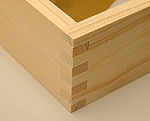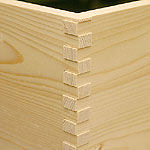This is a Veteran Owned site
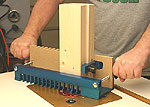 |
The Kwik Set Jig is easy to use and very accurate on wide or narrow boards. Click image to enlarge |
Kwik Set Box Joint Jig
Precision and Fit Without Frustration
Text & Photos by Tom Hintz
Posted - 10-27-2005
Note: It appears that this company is no longer with us. I have no information about if this jig is going to be available again or not.
Box joints (also called finger joints) look simple but in reality, represent one of the more frequent sources of frustration for woodworkers. Even tiny errors in spacing, something extremely difficult to avoid in a shop-built jig, compound as the length of the joint increases. The result is an ill-fitting joint that can require lots of corrective massaging. Enter the Kwik Set Box Joint Jig.
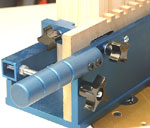 |
Assembling the Kwik Set Jig is fast and easy. Once together, it is tool-free in operation. Click image to enlarge |
Initial Impressions
The Kwik Set Jig (Goodview Design Inc.) is a study in the sanity sound engineering and high-dollar CNC (computer numerically controlled) equipment can bring to woodworking. Made primarily from solid aluminum that has been cleanly machined and anodized, the Kwik Set Jig is simple to use and effective. If anything, the parts that make up the Kwik Set Jig appear a little over-built for the task but that is a welcome deviation from the norm that promises long-term consistency and life.
Assembly and Setup
There is little in the way of assembly or setup as the main portion of the Kwik Set Jig consists of a single piece of machined aluminum. The remaining pieces attach with simple screws and bolts with no mystery involved. A nice touch is that all adjustable parts have finger-operated knobs, making this a tool-free jig once assembled.
 |
A 1/2" OD collar fits the jigs slots closely and produces very nice fitting joints. Click image to enlarge |
Once assembled, the most important part of the instructions is using the right combination of bit and collar. We chose a ½"-shank, 3/8" straight cutter (Infinity Tools #11-595) and a Porter Cable guide collar with a ½" outside diameter. The instructions specify other combinations for using 5/16" and ¼"-diameter bits but because the Kwik Set Jig always cuts 3/8"-wide joints, multiple passes are required with the smaller bits though this does not appear to be a problem nor does it compromise the quality of the joint.
In the Shop
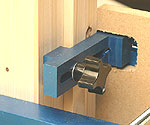 |
The adjustable offset block works perfectly and is a no-brainer to set. Click image to enlarge |
The instructions that come with the Kwik Set Jig do a good job of explaining how to use it, including on large stock that is clamped in a vise. All of our testing was done with material sizes common to the home woodworking shop. All of the cuts made on our Woodpeckers router table, equipped with their PRL lift plate and a Porter Cable #7518 router. Smaller horsepower routers will do fine with this jig because the maximum bit diameter is only 3/8".
The MDF (medium density fiberboard) zero clearance board has a set of notches machined into it that correspond to and align with the pathways in the jig below. This makes installing the material to be cut so the fingers are cut with equal partial fingers at the top and bottom, very easy. Align the stock as needed, move the side stop
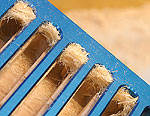 |
The close fit between collar and jig make the occasional pack of dust inescapable. It clears easily and a quick re-cut insures perfection. Click image to enlarge |
over and secure it. An offset block on the side stop automatically positions the two of the work pieces so that offset joints are cut into them for a perfect fit when assembled. Both the side stop and offset block can be repositioned to accommodate stock in the 1/8" to ¾"-thickness range the Kwik Set Jig is designed to work with.
The MDF board also functions as a backer board that is cut to shape the first time the jig is used. Because the joints are cut identically each time, the MDF board needs no further modification.
The instruction manual gives setup specs for bit height but we found it easiest to simply set a scrap of the material being cut on the floor of the jig and adjusting cutter height slightly above that to insure pins that are a bit longer than needed so they can be sanded flush after assembly. To prove the accuracy of this, I neglected to reset the bit height before cutting a wide set of boards that were a little thinner than the previous ones. The cuts turned out exactly deeper than needed by the amount I forgot to lower the bit. The jig is perfect, I was not.
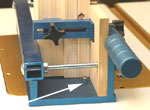 |
Cutting stock wider than the jig is simple due to the locator pin that allows indexing the stock correctly for the next set of cuts. Click image to enlarge |
I also discovered that when cutting full ¾"-thick stock, using a bit with 1 ¼"-tall cutters is a very good idea. The stock I used was planed to about 5/8" thick, putting it within easy reach of my bit with 1"-tall cutters.
Setting the stock up in the clamp was a little tough until I tightened the clamping bar slightly and then aligned the pieces. Being able to reposition the offset block is also a great idea that makes working with various stock thicknesses a snap.
Though we used the effective dust control system on our Woodpeckers table, the precise fit of the collar to the jig meant that sawdust would occasionally become packed in those passages. Cleaning that debris from the jig and making a final pass to be sure all fingers are fully cut eliminated any problems.
Between the weight of the Kwik Set Jig itself and the large diameter handles, control is easy and very positive feeling. The all aluminum base reduces surface friction to unimportant levels that seemed to have no impact on cutting joints.
Against my better judgment, I used plain pine for the testing despite fears it would simply blow out at the ends. Somewhere between using a quality Infinity bit and the accuracy of the Kwik Set Jig, there were virtually no blown out edges.
Regardless of the stock width, the Kwik Set Jig cut perfect-fitting joints that slipped together with just enough room for a good coat of glue. Boards 12"-wide fit just as easily as 4"-wide ones. The dreaded accumulating error problem so often found in shop-built jigs is none existent with the Kwik Set Jig.
The instructions show how to use the Kwik Set Jig on large panels that are clamped in a vise, clamping the Kwik Set Jig to them. A built-in repositioning pin allows cutting all the joints in the jig, indexing it over and continuing for as long as the board is. Want to cut box joints in a 7-foot-tall hutch? If you can clamp it to remain steady, the Kwik Set Jig will handle them.
Conclusions
 |
If you want to make box joints, the Kwik Set Jig could be the answer you are looking for. Click image to enlarge |
The Kwik Set Jig is a very well built piece of equipment that makes the once frustrating box joint fun to make for anyone that can follow the easy to understand instructions. If the stock is cut square and the right bit-collar combination used, you almost have to try to make a bad or ill-fitting joint.
With a street price of $189.95 (10-27-2005) is not overly cheap, but you get quite a bit for the money. In addition to the substantial construction, materials and tool-free operation, the Kwik Set Jig does what it says it does and then some. That alone is worth some money in today's woodworking marketplace.
Note: It appears that this company is no longer with us. I have no information about if this jig is going to be available again or not.
Do you have a comment on this review? – Email Me!
All written, photographic and drawn materials are property of and copyright by NewWoodworker.com LLC 2000-2019. Materials may not be used in any way without the written permission of the owner.

